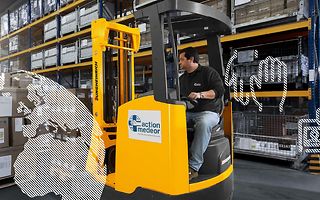We offer the unique competence of the manufacturer
The most reliable method for assessing vibration exposure is to take on-site measurements – directly on the trucks, in everyday operating conditions. Our service engineers can take these measurements for you. This includes drawing up a record of the measurement results and suggestions for reducing human vibration.
How are the measurements taken?
The operator is asked to draw up a list of his industrial trucks, with details of the tasks performed and the length of exposure to vibration for each truck. For each typical task category, areas are selected for measurement. Our trained specialists then take the measurements on the relevant trucks in the designated areas, in normal operating conditions.
A measurement cushion placed on the driver's seat or operator platform is used to record the vibrations occurring in the routine work environment. This means that all key factors (such as seat adjustment, surface quality, truck type and condition and driving style) can be fully taken into account. The daily exposure value is then calculated and documented on the basis of the measurements for specific operating scenarios and the duration of vibration exposure.
What needs to be remembered during the measurement process?
Because of the wide variation in surface conditions and the different ways in which companies use their industrial trucks, it is not possible to provide any universal advice. But one frequent source of measurement errors is the human being operating the truck! The act of climbing on and off the truck can cause vibration spikes (particularly if the driver jumps up onto the platform or seat where the sensor is located).
Along with the hazard assessment itself, there are a number of further items that need to be considered:
Is the seat set adjustment correct?
Has the truck been properly maintained?
Are the tyres new, with normal wear, or already well worn?
Once all these items have been dealt with, the measurements can start.
Further countermeasures to reduce vibration:
Training courses to raise driver awareness of the problem.
Encouraging changes in driving habits to minimise vibration.
Checking the quality of the surface, with repairs if required.
Maintenance programmes for workplaces, trucks, equipment and access ways.
Consideration of alternative lower-vibration logistics processes. For example: use of mast stackers with super-elastic tyres (Jungheinrich ETV C for combined interior/exterior use).
Adjust workflows to include adequate periods with no exposure to vibration.




